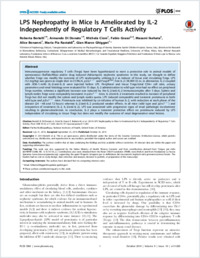LPS nephropathy in mice is ameliorated by IL-2 independently of regulatory T cells activity
- Bertelli, Roberta Division of Nephrology, Dialysis, Transplantation and Laboratory on Physiopathology of Uremia, Giannina Gaslini Children Hospital, Genoa, Italy
- Di Donato, Armando Division of Nephrology, Dialysis, Transplantation and Laboratory on Physiopathology of Uremia, Giannina Gaslini Children Hospital, Genoa, Italy
- Cioni, Michela Division of Nephrology, Dialysis, Transplantation and Laboratory on Physiopathology of Uremia, Giannina Gaslini Children Hospital, Genoa, Italy
- Grassi, Fabio Institute for Research in Biomedicine (IRB), Faculty of Biomedical Sciences, Università della Svizzera italiana, Switzerland - Department of Medical Biotechnologies and Translational Medicine, University of Milan, Milan, Italy
- Ikehata, Masami Department of Medical Biotechnologies and Translational Medicine, University of Milan, Milan, Italy
- Bonanni, Alice Division of Nephrology, Dialysis, Transplantation and Laboratory on Physiopathology of Uremia, Giannina Gaslini Children Hospital, Genoa, Italy
- Rastaldi, Maria Pia Renal Research Laboratory, Fondazione Istituto di Ricerca e Cura a carattere Scientifico (IRCCS ) Ca’ Granda Ospedale Maggiore Policlinico and Fondazione D’Amico per la Ricerca sulle Malattie Renali, Milano, Italy
- Ghiggeri, Gian Marco Division of Nephrology, Dialysis, Transplantation and Laboratory on Physiopathology of Uremia, Giannina Gaslini Children Hospital, Genoa, Italy
-
24.10.2014
Published in:
- Plos one. - 2014, vol. 9, no. 10, p. e111285
English
Immunosuppressive regulatory T cells (Tregs) have been hypothesized to exert a protective role in animal models of spontaneous (Buffalo/Mna) and/or drug induced (Adriamycin) nephrotic syndrome. In this study, we thought to define whether Tregs can modify the outcome of LPS nephropathy utilizing IL-2 as inducer of tissue and circulating Tregs. LPS (12 mg/Kg) was given as single shot in C57BL/6, p2rx7−/− and Foxp3EGFP; free IL-2 (18.000 U) or, in alternative, IL-2 coupled with JES6-1 mAb (IL-2/anti-IL-2) were injected before LPS. Peripheral and tissue Tregs/total CD4+ cell ratio, urinary parameters and renal histology were evaluated for 15 days. IL-2 administration to wild type mice had no effect on peripheral Tregs number, whereas a significant increase was induced by the IL-2/anti-IL-2 immunocomplex after 5 days. Spleen and lymph nodes Tregs were comparably increased. In p2rx7−/− mice, IL-2/anti-IL-2 treatment resulted in increase of peripheral Tregs but did not modify the spleen and lymph nodes quota. LPS induced comparable and transient proteinuria in both wild type and p2rx7−/− mice. Proteinuria was inhibited by co-infusion of human IL-2, with reduction at each phase of the disease (24 −48 and 72 hours) whereas IL-2/anti-IL-2 produced weaker effects. In all mice (wild type and p2rx7−/−) and irrespective of treatment (IL-2, IL-2/anti-IL-2), LPS was associated with progressive signs of renal pathologic involvement resulting in glomerulosclerosis. In conclusion, IL-2 plays a transient protective effect on proteinuria induced by LPS independent of circulating or tissue Tregs but does not modify the outcome of renal degenerative renal lesions.
- Language
-
- English
- Classification
- Medicine
- License
- Open access status
- gold
- Identifiers
-
- RERO DOC 326839
- DOI 10.1371/journal.pone.0111285
- ARK ark:/12658/srd1319118
- Persistent URL
- https://n2t.net/ark:/12658/srd1319118
Statistics
Document views: 195
File downloads:
- Texte intégral: 140
